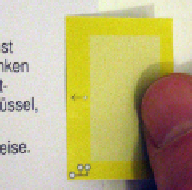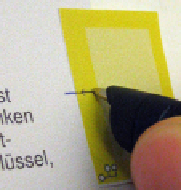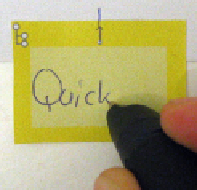Information Technology Reference
In-Depth Information
The interaction for creating a Digital Paper Bookmark is inspired by traditional
bookmarking practice. It involes three steps (see Fig.7.2):
1.
Combining:
A bookmark is attached to an arbitrary page of a printed document
at arbitrary positions. Several bookmarks can be attached to the same page. The
document has to be covered with the Anoto pattern.
2.
Associate (bridging):
With a simple pen gesture, the paper bookmark is associ-
ated with the page it is attached to. It is then also available as digital bookmark.
This association gesture is a short line connecting the bookmark with the page it
is attached to. An arrow is printed on the bookmark to indicate the pen gesture
(see Fig. 7.3).
3.
Label (inking):
Since the Anoto pattern is printed on the stickers, one can use the
digital pen to write a tag or a title on them, which will be synchronized.
The interaction thus combines three core interactions of our interaction model
(see Section 3.4.2). The association step is not necessary if technology for tracking
the location of paper sheets is used, which automatically detects the combination.
The manual association lowers the technical requirements and enables bookmarking
during mobile use. This proposed solution for creating bookmarks is entirely mobile
and highly compatible with existing practices.
After creation, the position of a bookmark can be modified by attaching the book-
mark to another physical position and performing the association gesture at this new
position. Handwritten labels can also be modified. A bookmark can be deleted by
physically removing it from the paper sheet and performing a cross-out gesture on
the bookmark for deleting its digital counterpart.
A Digital Paper Bookmark has a dual function: It is an
instrument
for creating,
modifying and deleting tags. Once created, the instrument also becomes a
first-class
(a) Combine
(b) Bridge
(c) Label
+
+
Fig. 7.2
Three intuitive steps allow the user to create a Digital Paper Bookmark. These correspond
to three core interactions of our interaction model












